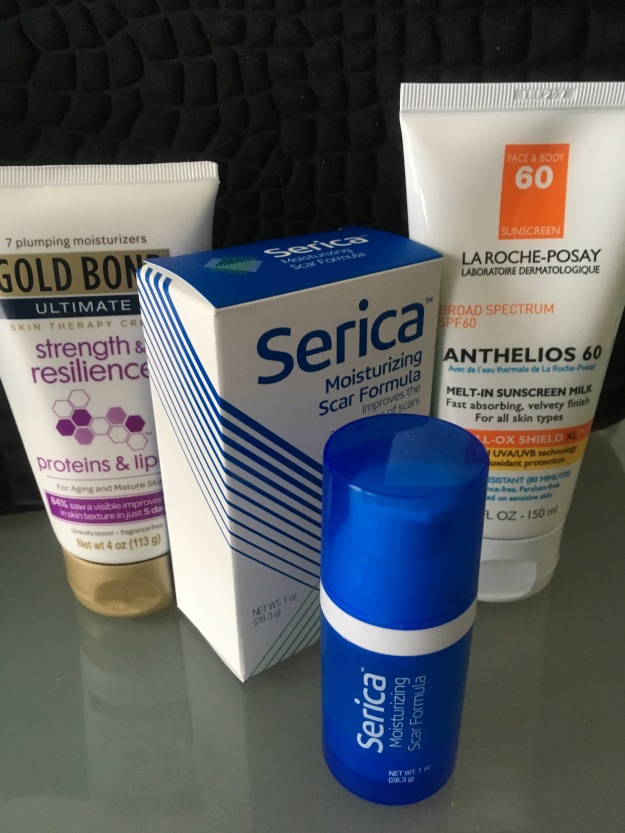This getting older thing seems to require ever-greater vigilance. The wear and tear of sun exposure and general activity caught up with me recently, resulting in a few rounds of sclerotherapy and in-office surgery for a squamous cell (non-melanoma) carcinoma.

Prominent veins are much prettier on leaves
First, the vanity part: sclerotherapy.
I’ve made peace with my legs’ freckles, moles, scars and other mementoes of time but one thing was really bothering me: clusters of ugly spider veins around my ankles that had appeared over the past few years. (Thanks, gravity!)
Since boots are not a year-round option and the distracting power of red nail polish only goes so far, I finally decided to do something.
Sclerotherapy is commonly used to treat varicose veins or spider veins. Depending on the types of veins affected, lasers and other methods may be indicated. In my case, sclerotherapy was the recommendation and – spoiler alert – it has made a difference.
The procedure is non-surgical, doesn’t require anesthesia, and, in most cases, doesn’t require any special preparation. Your doctor injects a solution (called a sclerosant) into the blood vessels or lymph vessels, which causes them to swell and cut off the flow of blood or lymphatic fluid to the veins, which in turn makes them shrink. The practitioner can actually see them disappear – how cool is that?
During the treatment, you lie on your back with your legs up. After cleaning the area, the doctor injects the vein with the irritant. You may feel burning, tingling, or nothing at all. In my case there was some stinging but it wasn’t too bad. When the injection is complete, the doctor massages the area to prevent blood from re-entering the vein. Depending on the area being treated compression socks may be helpful afterwards.
After treatment, you need to remain active to prevent blood clots from forming, and avoid sunlight, which can cause dark spots at the treated area. Other than some soreness, redness and bruising at the injection site, recovery is easy.
Research suggests that sclerotherapy effectively removes spider veins in 75-90% of cases, but typically requires multiple treatments. It took me 3 sessions to remove all but the most visible cluster, which has not gone away completely but is much lighter. Unfortunately, the procedure isn’t covered by insurance and since standing and walking put pressure on the veins, they’ll probably come back eventually. I’m hoping it takes a few decades.
Necessity: skin cancer prevention
Being fair-skinned and paranoid, I’m vigilant about sun block and see my dermatologist annually for a full-body skin check. This time, I called her attention to a small but tenacious spot on the back of my hand and she agreed that a biopsy should be done. Most red spots resolve within a month (a bit longer as we get older and our skin takes more time to heal). Anything that doesn’t go away should be evaluated.
Turns out I had a squamous cell non-melanoma carcinoma, the second most common form after basal cell carcinoma. Not life threatening, but not something you want to ignore, either. We scheduled surgery for a couple of weeks later.
Skin cancer is the most common of all cancers; each year in the U.S. nearly 5 1/2 million cases of non-melanoma skin cancer are treated in more than 3.3 million people. It’s also the easiest to cure when diagnosed and treated early. The head (particularly if you have thinning hair), face, tops of the ears and back of the hands are especially vulnerable. Hats and gloves, people! And wear sun block every day, including driving and swanning about in your corner office with the big windows!
Dermatologists used to focus on brown, unevenly shaped or mottled moles. But scientists have now learned that melanomas can also be pink or red. Be on the lookout for areas that are rough, red and raised. Often you’ll detect anomalies more by feel than by the way they look.
Pre-op: The biopsy has removed most of the problem already, since squamous cells are in the top layer of skin. The pre-op prep includes avoiding blood thinners such as ibuprofen, certain supplements and alcohol the week before, plus cleaning the area in advance with an over-the-counter antibacterial liquid.
Day Of: First, the surgical area is numbed with a lidocaine injection. Mine is on my wrist so the incision is lateral and should be hidden by all the other creases. Surgery isn’t painful and I only need acetaminophen a couple of times in subsequent days.
A Week (Plus) Later: A nurse at the derm’s office removes the stitches and applies three Steri-Strips. These fall off after another week. Three weeks post-op, the back of my hand is still sore and puffy but is slowly improving.
After-care: Dr. D recommends Gold Bond Strength and Resilience to moisturize skin, Anthelios 60 sunscreen, and Serica for scar improvement – it’s much easier to apply this gel than bulky scar strips. I’m also trying it on last year’s bunion scar to see if it helps.

Dr. D has also suggested I try nicotinamide (B3) supplements. In the recent ONTRAC study, oral use significantly reduced the risk of melanoma in patients who’d had two or more precancerous basal or squamous lesions.

I’m taking 500 mg twice a day and will start seeing my derm twice a year from now on. I’ll also be ordering Anthelios by the truckload.

A very useful reminder and nicely detailed description. Thank you! I’m making the appointment for my body scan today……
LikeLiked by 1 person
Good for you!
LikeLike
Pingback: Scenes From a Derm Convention | olderfatterhappierdotcom